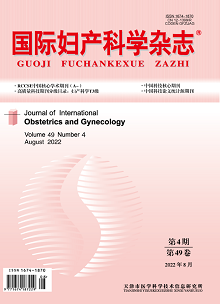Objective:To investigate the risk factors of lower extremity deep vein thrombosis (DVT) after laparoscopic excision of uterine fibroids, and to establish a risk nomogram model. Methods:The clinical data of 493 patients with uterine fibroids who underwent laparoscopic excision in our hospital from January 2017 to January 2021 were retrospectively analyzed, and the patients were divided into DVT group and non-DVT group according to whether DVT occurred after operation. According to the clinical conditions of the group, univariate and multivariate Logistic regression analysis was used to screen the influencing factors of DVT after laparoscopic removal of uterine fibroids, and a nomogram risk model was established based on independent risk factors to verify the predictive efficacy. Results:Among 493 patients with uterine fibroids who underwent laparoscopic excision, 41 cases were complicated with lower extremity DVT after operation, and the incidence rate was 8.32% (41/493). The differences were statistically significant (P<0.05) when comparing age, body mass index, preoperative comorbidities, anesthesia, operative time, intraoperative pneumoperitoneal pressure, plasma D-dimer, and postoperative bed rest in the two groups. Multivariate Logistic regression analysis showed that age ≥ 60 years (OR=3.786, 95%CI: 1.749-8.197), preoperative comorbidities (OR=3.390, 95%CI: 1.524-7.543), general anesthesia (OR=3.778, 95%CI: 1.722-8.287), operation time ≥ 2 h (OR=2.884, 95%CI: 1.384-6.010), intraoperative pneumoperitoneum pressure ≥ 15 mmHg (OR=3.295, 95%CI: 1.539-7.055), plasma D-dimer ≥ 500 ng/mL (OR=4.141, 95%CI: 1.925-8.909), and postoperative bed rest time ≥ 5 d (OR=3.628, 95%CI: 1.710-7.697) were all independent risk factors for postoperative complications of lower limb DVT in patients with uterine fibroids (P<0.05); based on 7 independent risk factors, the nomogram early warning model of postoperative DTV in patients with uterine fibroids after laparoscopic excision was established. The results showed that age ≥60 years was 93 points, 85 points for preoperative complications, 93 points for general anesthesia, 74 points for operation time ≥2 h, 83 points for intraoperative pneumoperitoneum pressure ≥15 mmHg, 100 points for plasma D-dimer ≥500 ng/mL, and the postoperative bed rest time ≥5 days was 91 points. The model validation results showed that the C-index was 0.853 (95%CI: 0.822-0.884), and the predicted value of the calibration curve was basically the same as the measured value. Internally validated gynecological abdominal surgery patients were combined. The area under the ROC curve (AUC) of the risk nomogram model for lower extremity DVT was 0.832 (95%CI: 0.804-0.860). Conclusions:Age ≥60 years old, preoperative complications, general anesthesia, operation time≥ 2 h, intraoperative pneumoperitoneum pressure ≥15 mmHg, plasma D-dimer ≥500 ng/mL, and postoperative bed rest time ≥5 days were all independent risk factors for lower extremity DTV after laparoscopic myomectomy. The nomogram based on the above seven independent risk factors is helpful to predict the risk of lower extremity DTV after laparoscopic myomectomy.

